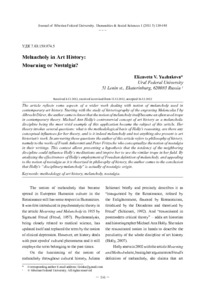Меланхолия в истории искусства: скорбь или ностальгия?
Скачать файл:
URI (для ссылок/цитирований):
https://elib.sfu-kras.ru/handle/2311/2644Автор:
Южакова, Е.В.
Yuzhakova, Elizaveta V.
Дата:
2012-01Аннотация:
The article reflects some aspects of a wider work dealing with notion of melancholy used in
contemporary art history. Starting with the study of historiography of the engraving Melencolia I by
Albrecht Dürer, the author came to know that the notion of melancholy itself became an often used trope
in contemporary theory. Michael Ann Hollys controversial concept of art history as a melancholic
discipline being the most vivid example of this application became the subject of this article. Her
theory invokes several questions: what is the methodological basis of Hollys reasoning, are there any
conceptual influences for her theory, and is it indeed melancholy and not anything else present is art
historians work. In answering these questions the author of this article refers to philosophy of history,
namely to the works of Frank Ankersmit and Peter Fritzsche who conceptualize the notion of nostalgia
in their writings. This context allows presenting a hypothesis that the tendency of the neighboring
discipline could influence Hollys meditations and inspire her to use the similar trope in her field. By
analyzing the effectiveness of Hollys employment of Freudian definition of melancholy, and appealing
to the notion of nostalgia as it is theorized in philosophy of history, the author comes to the conclusion
that Hollys disciplinary melancholy is actually of nostalgic origin. Статья отражает некоторые аспекты более широкой работы о понятии меланхолии,
используемом в современной истории искусства. Начав с исследования историографии
гравюры «Меланхолия I» Альбрехта Дюрера, автор обнаружил, что само понятие меланхолии
стало часто используемым тропом в современной теории. Наиболее яркий пример того -
противоречивая концепция Майкл Энн Холли истории искусства как меланхолической
дисциплины - стал предметом данной статьи. Теория Холли вызывает несколько вопросов:
какова методологическая основа ее рассуждений, есть ли какие-либо концепции, оказавшие
влияние на ее теорию, и действительно ли это меланхолия, а не что-либо другое, присущее
истории искусства. Отвечая на эти вопросы, автор данной статьи обращается к
философии истории, а именно, работам Франка Анкерсмита и Питера Фрицше, которые
концептуализировали понятие ностальгии в своих исследованиях. Этот контекст позволяет
представить гипотезу о том, что тенденции соседней дисциплины могли оказать влияние
на рассуждения Холли и вдохновить ее на использование похожего тропа в собственной
области. Анализируя эффективность использования Холли фрейдистского определения
меланхолии и обращаясь к понятию ностальгии в том виде, как оно разработано философией
истории, автор приходит к заключению, что происхождение меланхолии дисциплины Холли в
действительности ностальгическое.

